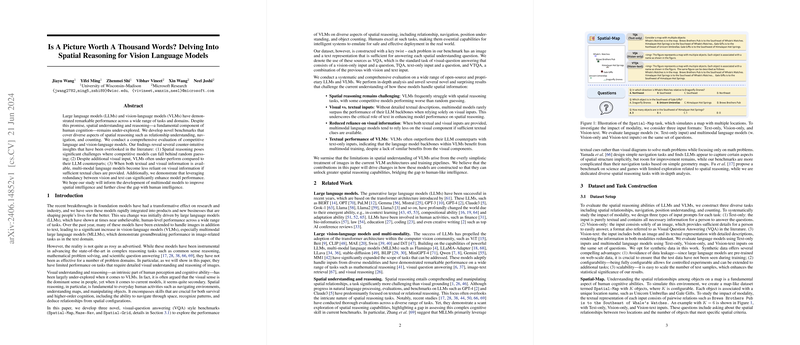Delving Into Spatial Reasoning for Vision-LLMs
The paper "Is A Picture Worth A Thousand Words? Delving Into Spatial Reasoning for Vision LLMs" by Jiayu Wang et al. meticulously examines the spatial reasoning capabilities of current LLMs and vision-LLMs (VLMs). The research highlights the limitations of these models in understanding and reasoning about spatial relationships, providing novel benchmarks that scrutinize various aspects of spatial intelligence.
Introduction
The paper starts by setting the context with the transformative impact that foundation models, particularly LLMs and VLMs, have had on numerous domains. Despite impressive advancements, the authors point out that spatial reasoning remains a challenging frontier. Visual understanding, which is inherently spatial, is under-explored in existing multimodal models. Spatial reasoning spans skills such as navigation, map reading, counting, and understanding spatial relationships—all crucial for real-world applications.
Novel Benchmarks
To address the gap in spatial reasoning research, the authors introduce three novel VQA-style benchmarks:
- Spatial-Map: This benchmark involves understanding the spatial relationships among objects on a map. Tasks include relationship questions (e.g., relative positions) and counting based on visual and textual inputs.
- Maze-Nav: This benchmark tests the model's ability to navigate mazes. It requires models to interpret starting positions, exits, and navigable paths, along with textual descriptions that map coordinates and objects.
- Spatial-Grid: Here, the dataset comprises grid-like environments where objects are placed in structured ways. Models are tested on counting specific objects and identifying objects at given coordinates.
Each benchmark is designed with three forms of inputs: text-only, vision-only, and combined vision-text, enabling a comprehensive analysis of how different modalities affect the reasoning performance.
Key Findings
The findings present several notable insights into the performance of current models:
- Challenges in Spatial Reasoning: The authors report that many competitive VLMs struggle significantly with spatial reasoning tasks. In some cases, their performance drops to the level of random guessing.
- Modality Impact: VLMs do not consistently outperform their LLM counterparts when visual inputs are the sole source of information. When combined visual and textual information is available, the models tend to rely more on textual clues, indicating limited utility derived from the vision component.
- Redundancy Benefits: Leveraging redundancy between vision and text can significantly enhance VLM performance. Tasks designed to be solvable via either modality show improved outcomes when both sources are available.
Implications
The implications of these findings are profound, both practically and theoretically. Practically, the limitations exposed by the paper suggest that current VLM architectures and training pipelines have inherent deficiencies in processing visual information for spatial reasoning tasks. To bridge this gap, future research should explore novel architectures that integrate visual and textual information more effectively, treating both as first-class citizens.
Theoretically, the insights challenge prevailing assumptions about VLMs' capabilities in handling multimodal inputs. The stark contrast between human spatial reasoning—which heavily relies on visual cues—and the models' reliance on textual information necessitates a rethinking of how these models are designed and trained.
Future Developments
The paper opens several avenues for future research:
- Architectural Innovations: Developing models that reason jointly in the vision and language space, rather than translating vision input into a language format, could provide more robust spatial understanding.
- Enhancing Training Pipelines: Incorporating richer, more diverse spatial reasoning tasks into training regimes may help models develop a deeper understanding of spatial cues.
- Benchmarks Expansion: Extending benchmarks to include more complex real-world scenarios and datasets can further push the boundaries of VLM capabilities.
Conclusion
The paper by Jiayu Wang et al. provides a rigorous examination of spatial reasoning in vision-LLMs, uncovering their current limitations and paving the way for future improvements. By creating innovative benchmarks and highlighting critical areas for enhancement, this research significantly contributes to the ongoing development of multimodal AI, bringing us closer to achieving human-like spatial intelligence in artificial systems.
